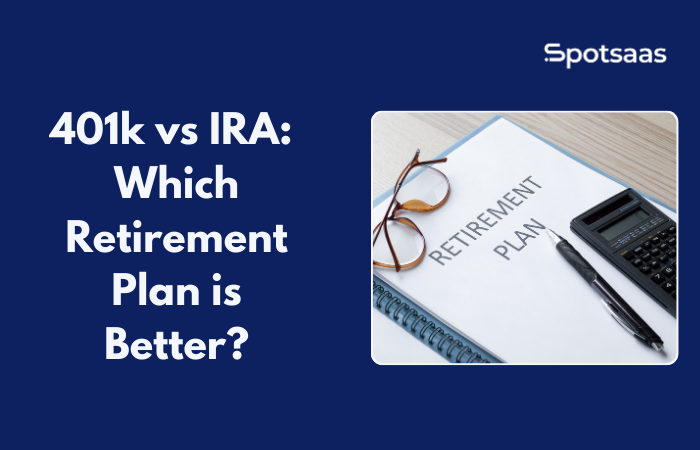Choosing the right savings plan is essential while planning for retirement for long-term financial security, 401k vs IRA needs to be chosen. However, each plan comes with its own set of rules, contribution limits, and benefits, making it crucial to understand which one best aligns with your financial goals.
A 401k is an employer-sponsored plan for retirement that help employees to contribute a portion of their salary, often with employer-matching contributions. On the other hand, an IRA is a personal retirement account that individuals can open independently, offering more investment flexibility but with lower contribution limits.
This guide will compare 401k and IRAs, covering their key differences, tax benefits, investment options, and withdrawal rules. By understanding how each plan works, can help make an informed decision on which retirement savings strategy is right for you.
What is a 401k?
401k is a retirement savings plan supported by employers. Eligible employees have the option to contribute a certain percentage of their salaries to the accounts. Contributions are usually deducted from their paychecks before reaching their 401k. Depending on the employer’s choice of plan, contributions can be made into a pre-tax (Traditional 401k) or post-tax (Roth 401k) account.
Stocks, bonds, mutual funds, ETFs, and target-date funds may be selected for all investments held in a 401k account. Investments within a 401k account grow tax-deferred, meaning that no gains or dividends can be taxed until withdrawn, or not at all in the case of an eligible Roth 401k withdrawal.

Employer Contributions
To stimulate savings for retirement, employers sometimes will match employees’ contributions to some level. The most common formula looks something like this:
- Dollar-for-dollar match up to a certain percentage (i.e., the company matches 100% of contributions up to 5% of the employee’s salary).
- Partial match (the employer may contribute 50 cents for every dollar an employee contributes, up to 6% of the employee’s salary).
Over time, these employer contributions can dramatically boost retirement savings. However, some companies do impose a vesting schedule, meaning that employees must work a certain length of time before they fully own the matched funds. If an employee leaves before they have become fully vested, they may forfeit some or all of the employer contributions.
Tax Benefits of a 401k
401k plans provide such tax advantages to help individuals considerably grow their retirement revenue.
Traditional 401k
Your contribution is made pre-tax, thus lowering your taxable income. Taxes are delayed by years because you’re supposed to pay them only with withdrawals on retirement. It does, however, pay off if your tax bracket is lower at retirement.
Roth 401k
Contributions are made after tax; thus, the amount withdrawn at retirement is tax-free, including its returns.
This option is well-suited to individuals expected to reach a higher tax bracket.
401k Contribution Limits (2024)
In accordance with the IRS rules, a 401k plan restricts contribution limits. For 2024, the contribution limits are as follows:
$23,000 a year for those below 50 years of age.
$30,500 a year for age and above 50 (includes $7,500 “catch-up” contribution).
The limits exceed by a great margin those of IRA, thus making it a very interesting plan for people wishing to save more for retirement.
401k Investment Options
Most 401k plans offer a number of investment options, including:
- Mutual funds – Professionally managed investment portfolios of stocks and bonds.
- Index funds – Funds designed to track a given stock market index, such as the S&P 500.
- Target date funds – Funds allocated automatically, dependent on the target retirement date.
- Company stock – Some companies allow employees to invest in the common stock of the company in which they work through their 401k.
401k Withdrawal Rules
- Because a 401k is designed for retirement savings, there are restrictions on withdrawals before retirement age.
- Early withdrawals (before 59½) typically incur a 10% penalty, plus income taxes on the withdrawn amount (Traditional 401k).
- Hardship withdrawals may be permitted for specific reasons like medical expenses or home purchases, though taxes and penalties may still apply.
- 401k loans may be available, allowing individuals to borrow against their savings and repay it over time without penalties.
- Required Minimum Distributions (RMDs) begin at age 73, ensuring retirees start withdrawing their savings.
Best For
- Employers offer two types of plans: A401k is meant for employees with access to an employer-sponsored plan, particularly those with matching contributions.
- An individual who wants tax-deferral or tax-free investment growth.
- An employee who wishes to save beyond the limits of an IRA.
- Some people like to contribute automatically through payroll deductions and have invested once, but they promptly forget about it.
Even without the employer’s matching contribution, the 401k is still a mighty instrument used for retirement savings because of its tax benefits and generous contribution limits.
What is an IRA?
An Individual Retirement Account (IRA) is a tax-advantaged savings account designed to help individuals build their retirement funds. Unlike a 401k, an IRA is not tied to an employer, meaning anyone with earned income can open and contribute to one.
IRAs offer greater investment flexibility and tax benefits, making them an attractive option for self-employed individuals or those looking to diversify their retirement savings.

Types of IRAs
Traditional IRA
A Traditional IRA allows individuals to make tax-deductible contributions, reducing their annual taxable income. The savings grow tax-deferred, meaning no taxes are paid on investment gains until withdrawals begin in retirement.
However, withdrawals are subject to income tax, and early withdrawals before age 59½ may incur a 10% penalty, except in specific hardship cases.
Roth IRA
A Roth IRA is funded with after-tax dollars, meaning contributions do not reduce taxable income. However, the major advantage is that withdrawals in retirement are completely tax-free, provided certain conditions are met.
Additionally, unlike a Traditional IRA, Roth IRA contributions (not earnings) can be withdrawn at any time without penalty, making it a flexible option for those who may need access to funds before retirement.
Contribution Limits
IRAs have lower contribution limits than 401k plans. As of 2024, individuals can contribute up to $7,000 per year, with an additional $1,000 catch-up contribution allowed for those 50 and older. While the limit is lower than a 401k, the tax advantages and investment flexibility make IRAs a valuable retirement tool.
Investment Options
One of the key advantages of an IRA is the broad range of investment choices. Unlike a 401k, which is typically limited to employer-selected funds, an IRA allows individuals to invest in:
- Stocks – Individual company shares for potential long-term growth.
- Bonds – Fixed-income securities offering lower risk and stability.
- ETFs – Exchange-traded funds providing diversified market exposure.
- Mutual Funds – Professionally managed portfolios tailored to different risk levels.
- Alternative Investments – Some IRAs allow real estate, commodities, or private equity investments.
This flexibility makes IRAs a powerful tool for individuals looking to customize their retirement investment strategy.
Withdrawal Rules
- Traditional IRA: Withdrawals before age 59½ incur a 10% penalty and are subject to income tax. Required Minimum Distributions (RMDs) start at age 73.
- Roth IRA: Contributions can be withdrawn penalty-free at any time. Earnings can also be withdrawn tax-free after age 59½, provided that the account has been open for at least five years.
IRA Contribution Limits (2024)
The Internal Revenue Service prescribes an annual contribution limit for IRAs:
- $7,000 per annum for those below 50 years.
- $8,000 per annum for persons 50 and above (which includes a catch-up contribution of $1,000).
Even though the IRA limits are lesser than those for 401(k), IRAs come with a multitude of options with more flexibility for handling money.
Best For
An IRA is an excellent retirement savings option for:
- Self-employed individuals or those with no access to a 401k.
- Employees looking to save more after reaching a 401k contribution limit.
- Those who wish to have more options for investments than those allowed in a 401k.
- Individuals wishing to make tax-free withdrawals in retirement (Roth IRAs).
Even if an employer offers a 401k plan, opening an IRA increases retirement savings with additional tax benefits and greater control over one’s investments.
Key Differences Between a 401k and IRA
Understanding the distinctions between a 401k and an Individual Retirement Account (IRA) is essential for effective retirement planning. Below is a comparison highlighting their primary features:
| Feature | 401k Plan | IRA |
|---|---|---|
| Eligibility | Offered by employers; available to employees. | Open to anyone with earned income; not employer-dependent. |
| Contribution Limits (2024) | Up to $23,000 annually; $30,500 for individuals aged 50 and above. | Up to $7,000 annually; $8,000 for individuals aged 50 and above. |
| Employer Contributions | Employers may match contributions, boosting retirement savings. | Not applicable; contributions are made solely by the individual. |
| Investment Choices | Limited to employer-selected funds, which may restrict investment diversity. | Offers a wide range of investments, including stocks, bonds, ETFs, and mutual funds. |
| Tax Benefits | Pre-tax (Traditional 401k) or post-tax (Roth 401k), affecting taxation upon withdrawal. | Pre-tax (Traditional IRA) or post-tax (Roth IRA), impacting tax treatment in retirement. |
| Withdrawal Rules | Early withdrawals before 59½ may incur penalties; RMDs start at age 73. | Roth IRAs allow tax-free withdrawals anytime; Traditional IRAs have penalties before 59½. |
| Best For | Employees looking to maximize savings, especially with employer matching. | Individuals seeking investment flexibility and those without employer-sponsored plans. |
Pros and Cons of 401k
| Pros | Cons |
|---|---|
| Higher contribution limits allow greater savings potential | Limited investment choices set by the employer |
| Employer matching contributions boost retirement savings | Early withdrawals are subject to penalties and taxes |
| Tax advantages help lower taxable income (Traditional) or provide tax-free withdrawals (Roth) | Required minimum distributions (RMDs) start at age 73 for Traditional 401k |
| Automatic payroll deductions make saving effortless | |
| Some plans allow loans, providing access to funds if needed |
Pros and Cons of IRA
| Pros | Cons |
|---|---|
| Greater investment flexibility with access to stocks, bonds, ETFs, and mutual funds | Lower contribution limits compared to a 401k ($7,000 in 2024; $8,000 for 50+) |
| Roth IRA offers tax-free withdrawals in retirement after meeting eligibility criteria | No employer matching contributions, meaning savings rely solely on personal contributions |
| Traditional IRA allows tax-deductible contributions, reducing taxable income | Income limits may restrict eligibility for Roth IRA contributions |
| No required minimum distributions (RMDs) for Roth IRAs | |
| Anyone with earned income can open an IRA, independent of employer sponsorship |
When to Choose a 401k Over an IRA
| Scenario | Why Choose a 401k Over an IRA? |
|---|---|
| Employer Matching Contributions | Many employers offer contribution matching, providing free money to grow retirement savings faster. |
| Higher Contribution Limits | A 401k allows for higher annual contributions ($23,000 in 2024; $30,500 for 50+), compared to an IRA ($7,000; $8,000 for 50+). |
| Automatic Payroll Deductions | Contributions are deducted directly from paychecks, making it easier to save consistently without needing manual transfers. |
| Structured Retirement Savings | A 401k enforces structured saving, helping employees set aside money for retirement without the risk of skipping contributions. |
Bottom Line:
A 401k is the better choice if you have access to an employer-sponsored plan with matching contributions, want to maximize savings with higher limits, and prefer automated payroll deductions. However, if your employer does not offer a 401k or you seek greater investment flexibility, an IRA could be a better alternative.
When to Choose an IRA Over a 401k
| Scenario | Why Choose an IRA Over a 401k? |
|---|---|
| More Investment Options | IRAs offer a wider range of investments, including stocks, bonds, ETFs, and real estate, while 401ks are limited to employer-selected funds. |
| No Access to a 401k | If your employer doesn’t offer a 401k, an IRA is the best alternative for tax-advantaged retirement savings. |
| Prefer Tax-Free Roth IRA Withdrawals | Roth IRAs allow tax-free withdrawals in retirement, unlike Roth 401ks, which have Required Minimum Distributions (RMDs). |
| Self-Employed or Part-Time Work | An IRA allows individuals without employer-sponsored plans to still save for retirement tax-efficiently. |
| Greater Control Over Investments | IRAs provide full control over investment strategy, offering more flexibility compared to employer-managed 401k plans. |
Bottom Line
An IRA is ideal if you want greater investment flexibility, don’t have access to a 401k, or prefer tax-free Roth IRA withdrawals in retirement. While a 401k is great for employer matching and higher contribution limits, an IRA provides more control, flexibility, and long-term tax benefits.
401k vs IRA: Choosing the Right Plan
| Factor | 401k Plan | IRA |
|---|---|---|
| Best For | Employees with employer contributions & higher savings goals. | Individuals who want more investment flexibility & tax options. |
| Investment Choices | Limited to employer-selected funds. | Broader selection, including stocks, bonds, ETFs, and mutual funds. |
| Tax Benefits | Pre-tax (Traditional 401k) or tax-free withdrawals (Roth 401k). | Tax-deductible contributions (Traditional IRA) or tax-free withdrawals (Roth IRA). |
| Contribution Limits (2024) | $23,000 ($30,500 for 50+). | $7,000 ($8,000 for 50+). |
| Employer Matching | Available if the employer offers it. | Not available. |
| Withdrawal Rules | Penalties apply for early withdrawals before 59½; RMDs at 73. | Roth IRA allows tax-free withdrawals; Traditional IRA has early withdrawal penalties. |
| Flexibility | Depends on employer rules & investment selection. | Full control over investment choices & plan selection. |
Bottom Line
If you have access to both a 401k and an IRA, contributing to both can help you maximize retirement savings, diversify investments, and optimize tax benefits. However, it’s essential to consider income limits for tax deductions and balance contributions to get the most out of employer matching and tax advantages.
Conclusion
Both 401k and IRAs offer valuable opportunities for building a secure retirement, but the right choice depends on your financial situation and long-term goals.
A 401k is ideal for employees who have access to an employer-sponsored plan, especially if matching contributions are available. It allows for higher annual contributions, making it a strong option for those looking to maximize their savings. However, investment choices are often limited to employer-selected funds, and early withdrawals come with penalties and taxes.
An IRA, on the other hand, provides greater investment flexibility, allowing individuals to select from a wide range of assets beyond what a 401k typically offers. It also offers tax advantages depending on whether you choose a Traditional or Roth IRA, but it comes with lower contribution limits and income-based eligibility restrictions.
Ultimately, the best approach is to evaluate income levels, employer benefits, and personal retirement goals. Many individuals choose to contribute to both a 401k and an IRA to take advantage of employer matches, higher savings limits, and broader investment options.
Frequently Asked Questions
Can I contribute to both a 401k and IRA?
Yes, you can contribute to both a 401k and IRA, but tax deductibility for Traditional IRA contributions may be limited if you also have a 401k through your employer and your income exceeds certain limits.
What happens if I withdraw from my 401k or IRA early?
Withdrawals from a Traditional 401k or IRA before age 59½ typically incur a 10% penalty plus income taxes. Roth IRAs allow you to withdraw contributions (but not earnings) tax-free at any time.
Which is better for tax benefits: 401k or IRA?
Both offer tax benefits: A Traditional 401k and Traditional IRA reduce taxable income upfront (taxed on withdrawal), while a Roth 401k and Roth IRA allow tax-free withdrawals in retirement (after-tax contributions). The best option depends on your current and expected future tax bracket.
Does a 401k or IRA have better investment options?
An IRA offers more investment flexibility, allowing you to choose from stocks, bonds, ETFs, mutual funds, and even real estate (self-directed IRAs). A 401k is limited to employer-selected investment options, which may have higher fees.
How do employer contributions work in a 401k?
Many employers match employee contributions up to a certain percentage (e.g., 50% of the first 6% of salary). Some employers require a vesting period before you gain full ownership of these contributions. IRAs do not offer employer contributions.





